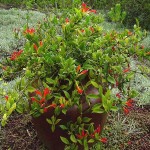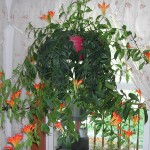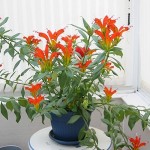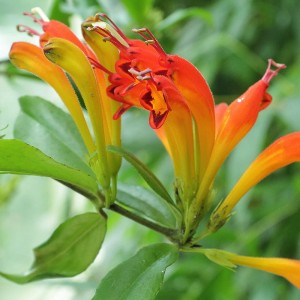Family: Gesneriaceae
Synonymous: Aeschynanthus aucklandiae
Aeschynanthus splendens
Distribution and habitat: Aeschynanthus speciosus is a species of trailing ephiphytic flowering plant, in wild growing on branches of trees in the tropical rainforests. It is native primarily to Southeast Asia (the Malay peninsula, Java and Borneo island). It is a perennial woody subshrubs. The stems are branchingand it has a spreading, weeping habit. The vines cascade downwards with long, graceful stems that can extend to more than 3m (10 feet) long.
As an epiphyte, Aeschynanthus speciosus does not live off its host like a parasite but rather, it takes nourishment from fallen leaves and twigs that accumulate in the crevices of tree's branches.
Description: Aeschynanthus speciosus is perhaps the most spectacular species within its genus. Its dark green leaves are carried along the stems in pairs or whorls of three, but there are 4 to 8 leaves at the stem tip, where they surround a cluster of 6 to 20 flowers. The leaves are up to 10cm (4 inch) long and 4cm (1.5 inch) wide and their tips are more sharply pointed than their bases. The green calyx sheathes only a portion of the flower, which may be 10cm (4 inch) long. Both calyx and corolla are slightly hairy. The flowers are orange with the inside of the mouth orange-yellow and with a dark red bar across the lower lobes which also have scarlet borders.
These plants normally have a summertime flowering season indoors and individual flowers last for only two or three days. An Aeschynanthus speciosus plant is displayed to best advantage in a hanging basket, where the broad surface area allows the trailing stems to root down at intervals and send out abundant side-shoots. The plant will mature in 2 to 5 years.
Proper care: Aeschynanthus speciosus are perfect as hanging or trailing plants. They require high humidity and warmth throughout the growing season, as well as strong, but not direct, light. These plants are perfect for a greenhouse, sunroom or conservatory.
After the season is over, cut the trailing stems back in preparation for another yearotherwise, it will tend toward leginess.
Light: Provide bright light for Aeschynanthus speciosus plants - but with no more than two or three hours of direct sunlight a day.
Temperature: Normal room temperatures are suitable for Aeschynanthus speciosus as long as humidity is kept high. Place trays of moist pebbles bellow the trailing stems and mist-spray plants daily during the flowering period. A humidifier can help to a great extent.
Avoid sudden temperature changes.
Watering: When an Aeschynanthus speciosus is in flower, water it plentifully. At other times water moderately, enough to make the mixture moist throughout, but allow the top 1cm (0.4 inch) to dry out between waterings. If kept in humid warmth, these plants do not have a rest period and so they require this much water all year long.
They must not be allowed to dry out when in bloom.
Feeding: Use a liquid fertiliser containing an equal-parts mixture of nitrogen, phosphate and potash. Apply a one-eighth-strength dose to these plants at every watering.
Potting and repotting: Since Aeschynanthus speciosus plants like an acid growing medium, coarse sphagnum peat moss may be used alone as the potting mixture. Equally suitable is an equal-parts mixture of peat moss and such substances as perlite and vermiculite which, if packed loosely, gives much-needed aeration around the roots.
Shallow 13 or 15cm (5-6 inch) pots or baskets are the best containers with several young plants placed in each for good effect. Repotting may be done at any time of year. When roots fill the pot, move plants into a pot one size larger. Or, preferably, cut them back by about one-third and repot the plants in the same pot, but with fresh potting mixture.
Gardening: Keep Aeschynanthus speciosus warm and humid in the spring and summer, above 18C (65F).The plant can withstand day temperatures of above 23C (75F) and 18 to 21C (65-70F) during the night; but the night temperatures should not be below 13C (55F). In the winter, a brief period of 13 to 18C (55-65F) will promote flowering. These plants require a humid atmosphere.
After the flowering season these plants may be trimmed. As the flowers emerge from the tips of the stalks, excessive trimming can hamper with flowering.
Position: As Aeschynanthus speciosus are native to tropical regions, they need humidity, moisture and sunlight for a healthy growth. Sunlight is one of the important factors that can affect the growth of these plants, but direct sunlight can cause adverse effects -the leaves can fall off or turn brown - unless the plants are kept moist. It is always better to grow these plants in a warm, part shaded location.
Soil: Aeschynanthus speciosus require for healthy growth evenly moist, fertile and well-drained soil. Light sandy soil with a mix of peat or humus is preferred for these plants.
Irrigation: Water Aeschynanthus speciosus plants generously, but take care not to make the soil soggy. Regular watering is more important during summers and in dry weather conditions, wherein the leaves can be moisten too to improve the atmospheric humidity. It is always better to use tepid water rather than cold water, as the latter may cause spots on the leaves that may also turn brown.
Fertilise: Adding fertilisers during the spring and summer season, can trigger flowering in Aeschynanthus speciosus plants. Use a nitrogen-free fertiliser at half the recommended strength, once in two weeks. The fertilising and watering frequency has to be reduced during the fall and winter, to allow the plant to get a resting period.
Propagation: Tip cutting 10-15cm (4-6 inch) long will root in three to four weeks at any season. Plant the cuttings in 8cm (3 inch) pots of the recommended potting mixture thoroughly moistened, enclosed them in plastic bags and keep them at normal room temperature in bright filtered light. When rooting has occurred, the bag should be removed and the new plants given just enough water to keep the potting mixture barely moist. About a week later pot several of the new plants together in a shallow 13 or 15cm (5-6 inch) pot and treat them as mature specimens. Make a particular effort to provide high humidity for these young plants.
Problems: If the Aeschynanthus speciosus plant has lost a lot of leaves over the winter, prune it more sharply, cutting the stems back to 15cm (6 inch) above their base.
Keep a watch for aphids which attack young leaves of Aeschynanthus speciosus. These tiny, highly prolific insects feed by sucking the plant sap. They form dense colonies on young shoots and under leaves and also feed on plant stems, bark, roots and fruit.
Treatment: Inspect the plant regularly for insects and use a suitable spray insecticide when necessary.
The scale insects (Coccoidea) are another pest capable of damaging Aeschynanthus speciosus plants when they are grown indoors.
Treatment: Spraying the plant with a diluted horticultural oil or soap can be an effective treatment.
Flower buds drop off and/or wilted leaves can be caused by not enough water during the growing period
Treatment: Immerse pot for 10 minutes in room temperature water and then let drain. After that adjust watering frequency.
Leaves drop off and roots rot can be caused by too much water in winter
Treatment: Cut off damaged roots and repot plant in a well-drained soil mixture. Consider cutting back on watering.
Leaf margins turn yellow and the new shoots drop off can be caused by the fact that the air around Aeschynanthus speciosus plant is too dry.
Treatment: Increase relative humidity by using a humidifier or place a tray with moist pebbles under plant pot and spray mist the foliage.
Avoid moving the plant once the flower buds have formed, to prevent them from dropping off.
Uses and display: In cultivation,Aeschynanthus speciosus is grown for its ornamental beauty in hanging baskets or pots, displaying long pendulous stems with dark green foliage and crowned with clusters of exotic flowers and buds in brilliant contrast. It is ideal as houseplants and for a conservatory or greenhouse. Perfect for hanging baskets/pots to best display their lovely cascading stems and attractive flowers or in containers placed on a pedestal or windowsill. A vine-like plant that can be trained as a climber on fences and wire-frames or grown on ground or allowed to creep on mossy rock surfaces.
The plant can be kept in a bathroom window sill or kitchen for increased humidity.
SUMMARY:
CHARACTERISTICS:
Foliage green
Features - flowers
Shape climbing and trailing
Height: 60-90cm (24-36 inch)
PROPER CARE:
Watering in active growth period plentifully
Light bright
Temperature in active growth period min 16C max 24C (61-75F)
Humidity high
Hardiness zone: 11





